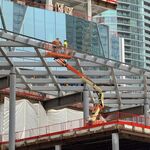innsertnamehere
Superstar
I think this corridor is especially possible given it's geometry, lack of need for expensive upgrades in locations, and feeding directly into a line that is scheduled for extensive upgrades.
Get the tracks updated to 90mph speeds, add a passing track or two, build two bare-bones stations in Angus and and Collingwood, and run some DMUs on it on an bi-hourly schedule or so direct to Union.
GO is expecting travel times to Barrie to drop to about an hour after RER is complete. Add another 30 minutes to get to Collingwood and you have an extremely time competitive travel option.
10 years ago it would have been completely ridiculous to consider, however not so much any more knowing what is happening on the Barrie Corridor.
Get the tracks updated to 90mph speeds, add a passing track or two, build two bare-bones stations in Angus and and Collingwood, and run some DMUs on it on an bi-hourly schedule or so direct to Union.
GO is expecting travel times to Barrie to drop to about an hour after RER is complete. Add another 30 minutes to get to Collingwood and you have an extremely time competitive travel option.
10 years ago it would have been completely ridiculous to consider, however not so much any more knowing what is happening on the Barrie Corridor.











